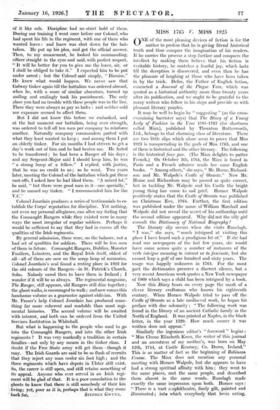MISS 1765 V. MISS 1925 O NE of the most pleasing
devices of fiction is for the author to profess that he is giving literal historical truth and thus conquer the imagination of his readers. If he carries the process a step further and conquers the intellect by making them believe that his fiction is veritable history, he snatches a fearful joy, which lasts till the deception is discovered, and even then he has the pleasure of laughing at those who have been taken in by the trick. Defoe, the Father of English fiction, concocted a Journal of the Plague Year, which was quoted as a historical authority more than twenty years after its publication, and we ought to be grateful to the many writers who follow in his steps and provide us with pleasant literary puzzles.
It may be well to begin by " suggesting " (as the cross- examining barrister says) that The Diary of a Young Lady of Fashion in the Year 1764-1765 (for shortness called Minx), published by Thornton Butterworth, Ltd., belongs to that charming class of literature. There are two little slips which alone seem to prove that Miss 1925 is masquerading in the garb of Miss 1765, and one of these is historical and the other literary. The following is the historical faux pas. (The Minx delights to patter French.) On October 5th, 1764, the Minx is bored in Paris and a French admirer sends her some English books. " Among others," she says, " Mr. Hume, Richard- son and Mr. Walpole's Castle of Otranto." Now Mr. Hume and Richardson may be passed as quite correct, but in tackling Mr. Walpole and his Castle the bright young thing has come to sad grief. Horace Walpole positively states that the Castle of Otranto was published on Christmas Eve, 1764. Further, the first edition was published under the name of William Marshall and Walpole did not reveal the secret of his authorship until the second edition appeared. Why did not the silly girl consult the Dictionary of National Biography ?
The literary slip occurs when she visits Ranelagh.
" I was," she says, " much intrigued at visiting this place I have heard such a prodigious lot of." If she had read our newspapers of the last few years, she would have come across quite -a number of instances of the verb intrigue meaning to interest or to fascinate, but she cannot leap a gulf of one hundred and sixty years. The usage was happily unknown in 1764. For the most . part the dictionaries preserve a discreet silence, but a very recent American work quotes a New York newspaper of 1909 which says a child has been intrigued by a book. Now this Diary bears on every page the mark of a clever literary craftsman who knows his eighteenth century. When Horace Walpole tried to pass off the Castle of Otranto as a late mediaeval work, he began his preface with due solemnity : " The following work was found in the library of an ancient Catholic family in the North of England. It was printed at Naples, in the black letter, in the year 1529. How much sooner it was written does not appear." • Similarly the ingenious editor's " foreword " begins : " Miss Cleone Elizabeth Knox, the writer of this journal and an ancestress of my mother's, was born on May 12th, 1744, at Castle Kearney, Co. Down, Ireland." This is as matter of fact as the beginning of Robinson Crusoe. The Minx does not mention any personal meeting with Horace Walpole, but she appears to have had a strong spiritual affinity with him ; they went to the same places, met the same people, and described them almost in the same words. Ranelagh made exactly the same impression upon both. . Horace says: "There is a vast amphitheatre, finely gilt, painted and illuminated ; into which everybody that loves eating, drinking, staring or crowding, - is admitted for twelve pence."
The bright young person notes : " Indeed 'tis very fine with its great amphitheatre finely gilt, painted and brilliantly - illuminated. The entrance is but twelve pennies and so the place is frequented by every kind of person, 4c." , • - - • - - By a lucky - coincidence both spent an autumn in Paris, Cleone in 1164 and Horace in 1765; and thus we have the opportunity of comparing their impressions which are remarkably alike. Both serve up substantially the same anecdote to illustrate the heartless -nature of the Parisians. These volatile _ people, it seems, when some terrible calamity happens to a friend, chatter Vehemently over it for a while and then, getting bored with the subject, dismiss it with the callous remark= " On n'en parle plus." - - - - - - Undoubtedly anyone who wishes to reproduce the atmosphere of the eighteenth century should give his -days , and nights to Horace Walpole. Smollett also is useful. The Minx clearly had read Roderick Random and Peregrine Pickle. The still more congenial Humphry Clinker and Travels had not been published in 1765, but doubtless in their happy Irish home these works would be read aloud to Cleone by her dear Mr. A., and they would compare them with the Diary _ and note coincidences in matter and spirit. Everyone will share the editor's regret when he remarks that, 'owing to the destruction by fire of Castle Kearney in 1808, there, unfortunately, is no existing portrait or miniature of Miss Knox."
This inconvenient and persistent Irish habit of burning down Castles has had another unfortunate result. It is possible that there lurked in the archives of Castle Kearney an extra early pirated first edition of the Castle of Otranto, of which even the author knew nothing. Had it been rescued from the flames, connoisseurs would be now willing to pay an enormous price for it.
W. A. HIRST.















































 Previous page
Previous page